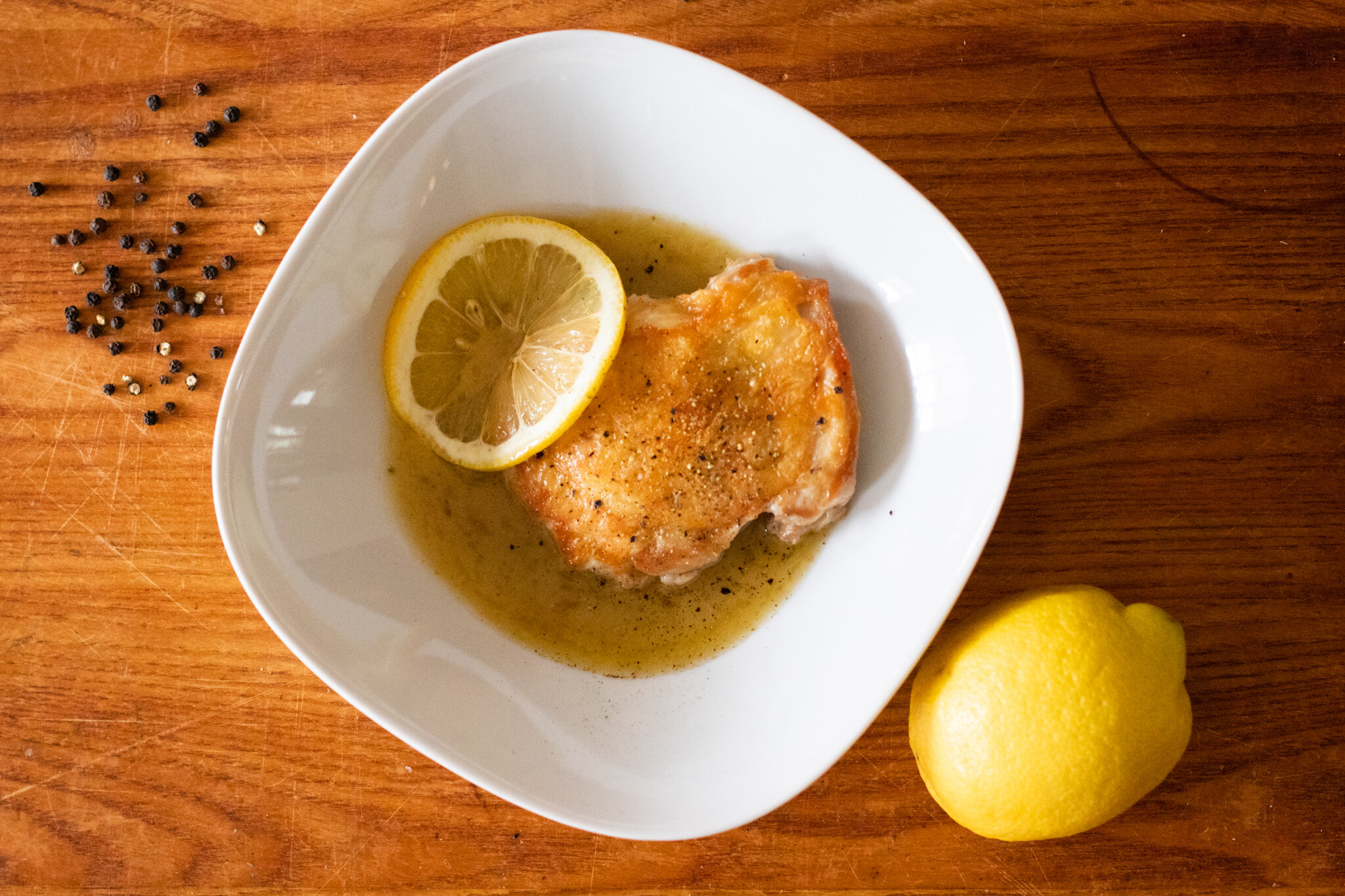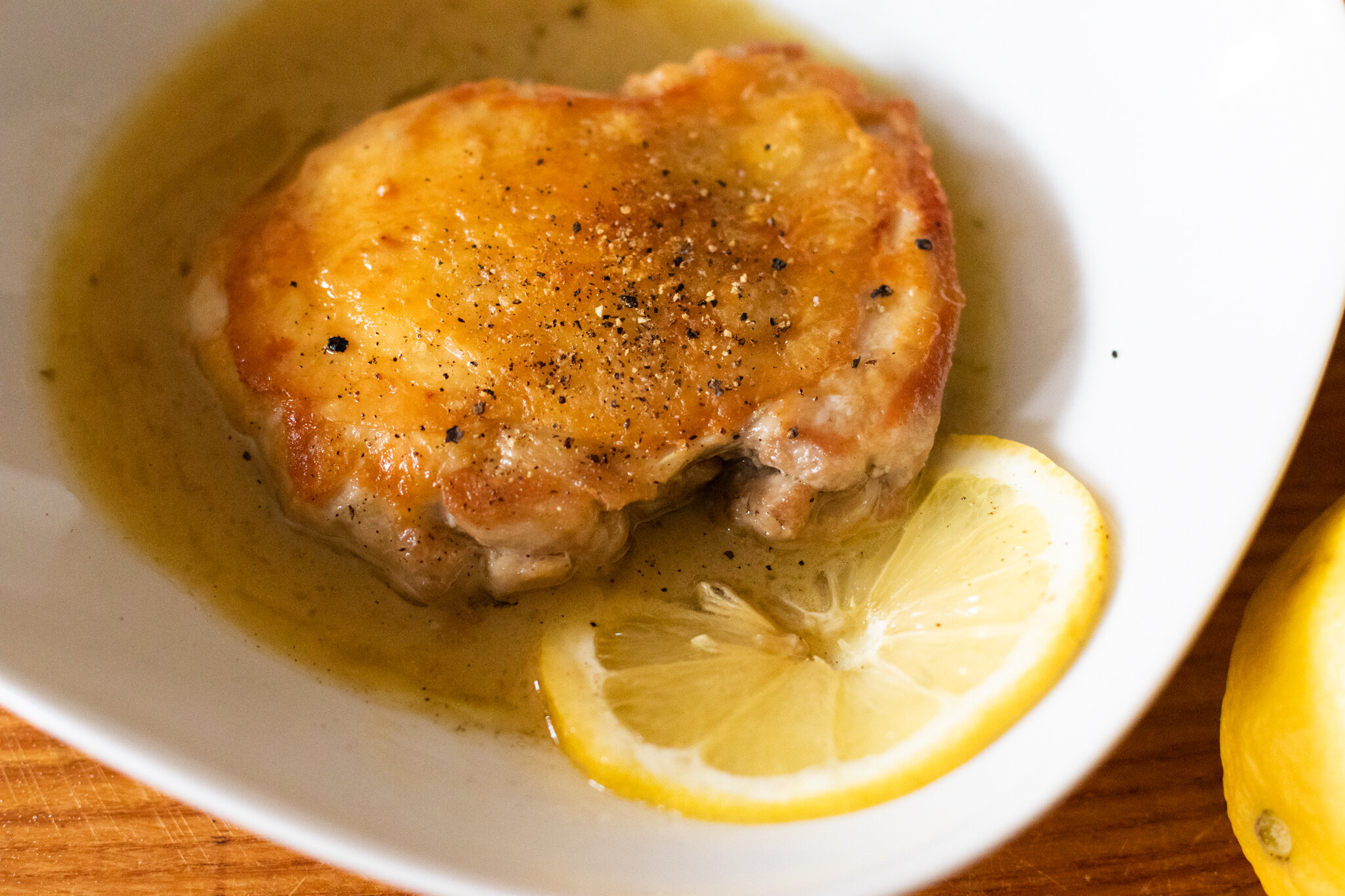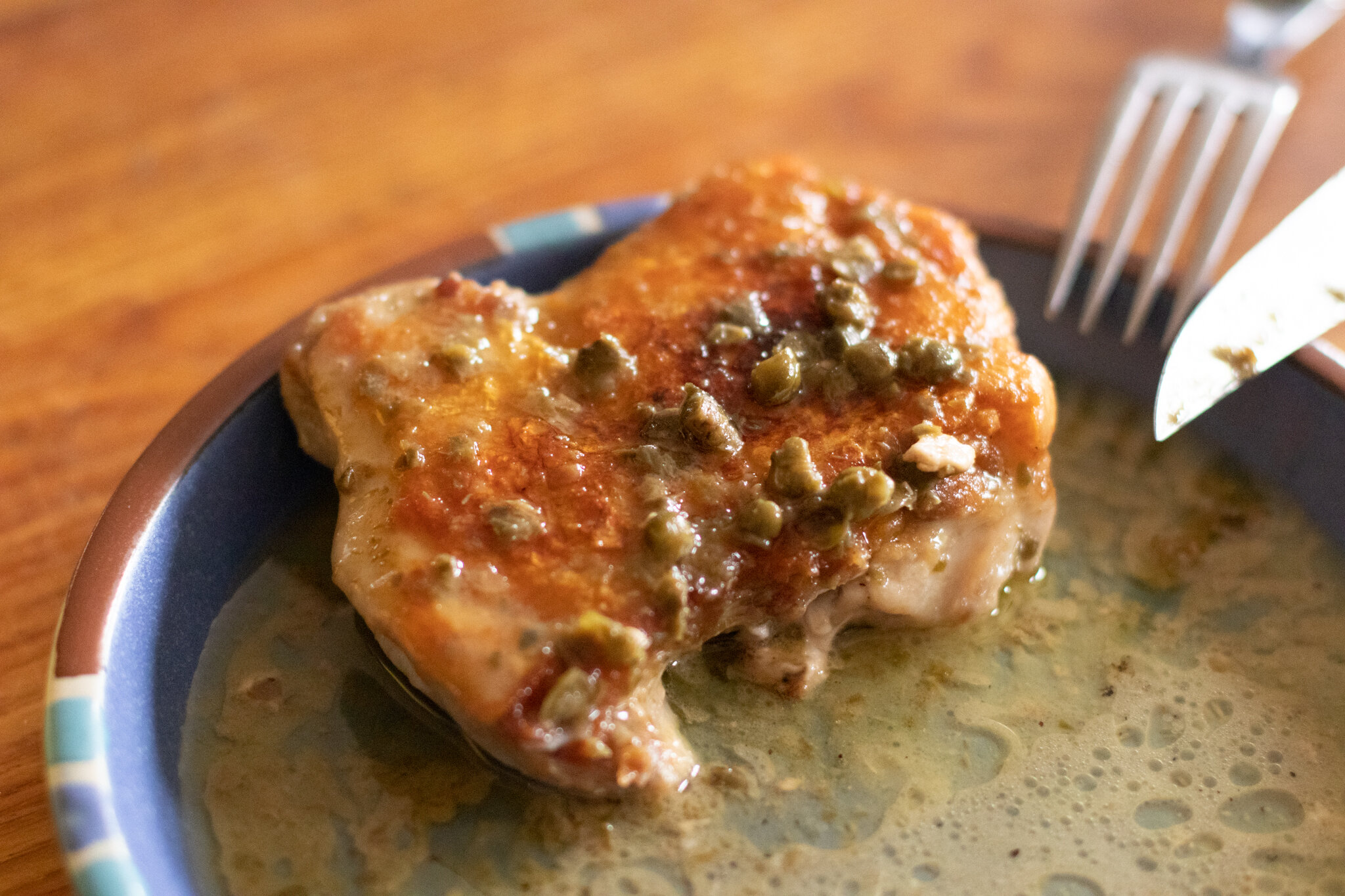Brick Chicken Piccata
For the first pairing-recipe in our month of wine, we’re breaking out a new recipe we just developed! To pair with the brightness of acidic white wines, we’re presenting Brick Chicken Piccata. Brick chicken is a method of cooking in which a piece of skin-on chicken is pressed into a hot pan under a weight, crisping the skin and helping cook the chicken evenly, while chicken Piccata offers substantial brightness from the addition of capers and lemon juice. As a result, this dish is both deeply rich and surprisingly bright, giving an acidic white wine brightness to match and fattiness to cut through. What’s more, this recipe lets nothing go to waste, upcycling the bone and excess fat from the chicken thighs themselves into a delicious stock. As an aside, if you’d like to save money and reduce your waste even further, consider buying your chicken whole and butchering it yourself! So, open up a bottle of wine, and check out this recipe below!
Ingredients
2 servings:
2 chicken thighs: bone in, skin on
1 tbsp butter: chilled
2-3 tbsp dry white wine
½ tbsp capers: coarsely chopped
1 Lemon: or 1-2 tbsp of juice, fresh preferably
Olive oil: 3 tbsp
Salt
Preparation
Carefully remove the bones from the thighs, as well as any larger chunks of extraneous fat from the chicken, making sure to leave the skin intact. Pat the thighs dry, liberally salt both sides of both thighs, and place covered in the refrigerator.
Add your bones, any excess fat, some vegetable scraps if you have any on hand, the wine, and 1 cup of water to a small sauce pan on medium heat, and cover. Let simmer, covered, for 45 minutes.
While the stock is simmering, chop your capers into small chunks, juice your lemon, and dice your butter into roughly ½ cubes.
Wrap something flat and heavy in tin foil — the “brick” part of “brick chicken” comes from using a foil-wrapped brick, though I often wrap a sheet of foil around a cast iron pan and use that instead.
Once your stock has been cooking for 45 minutes, remove your chicken from the refrigerator.
Strain your stock, add it back into the saucepan, and simmer to reduce for 10-15 minutes. Season to taste once reduced.
Place your oil in a medium pan (it should be much larger than the two thighs) on high heat. Once the oil is hot (shimmering), add in your chicken thighs, skin-side down, and place your weight on top. After 2 minutes, remove the weight, and check to see if the skin is browning. If it has browned significantly, reduce the heat to medium-low and return the weight. Otherwise, let them cook for another minute and then proceed.
Cook on medium-low heat for another 8-10 minutes (or until the skin is thoroughly golden brown and the skinless-side of the thigh is just cooked through), then remove from the pan to a plate or tray, skin-side up, and lightly season with salt. If the skin is browning too much and the thigh is still raw on top, flip it over to cook it on the skinless side for 2 minutes.
In the same pan (don’t clean it out!) turn the heat up to medium, add in your capers and 3 tbsp of your reduced stock, and stir well, making sure to scrape up everything from the bottom of the pan. Once the stock is on a low simmer and everything has been scraped up, lower the heat to medium-low, add in your butter, and stir vigorously and continuously while shaking the pan back and forth. If you don’t stir well, the sauce won’t emulsify. Once your sauce has thickened substantially, remove it from the heat.
Season your sauce with salt and lemon juice to taste and stir well.
Distribute your sauce between two small plates (or one per thigh if you scaled the recipe up or down), and plate your thighs, skin-side-up, in the sauce. Garnish with extra capers and lemon wedges, and feel free to spoon a bit of sauce on top of each thigh before serving. Enjoy!
If choosing to drink, make sure to enjoy this with an acidic white wine if possible! The bright acidity of the wine will both pair with the capers and lemon, and help cut through the rich fattiness of the chicken thighs and the butter-pan-sauce. Cheers!
Best Practices
As always:
This recipe relies heavily on packaged goods. That said, not all packaging is made equal! Make sure to opt for food packaged in recyclable containers, or, better yet, not packaged at all. Whole chickens can often be found in the butcher section of grocery stores (or simply in butcher shops) without any additional packaging, and lemons may be found without any packaging as well. As for the oil and capers, try to choose options with recyclable containers (like glass or specific types of plastic) if possible!
Try to bring your own reusable bags when you go shopping for these ingredients, and choose grocery store chains that are engaged in their community.
These ingredients have been chosen with several things in mind:
This recipe is centered around chicken, and while many animal products can place a larger burden on our environment than their plant-protein counterparts, remaining diligent when sourcing your chicken can make a world of difference. We make an effort on Grounded Grub to reduce our promotion of meat and dairy products for a variety of reasons, but we fully recognize that not all people feel they are able to go plant-based or plant-focused, and we also recognize that there can be a place for meat and dairy in a sustainable and plant-focused diet. Within this framework, we still encourage people to think about their options—not all animal-products are created equal, particularly from environmental, ethical, and health-focused standpoints.
While this recipe does rely on many packaged goods, that doesn’t mean you can’t still source them locally! Wine from local vineyards, butter from local dairy farms, and chicken from local farms all help to support local communities and can greatly reduce the huge energy demand of our national/international food systems.
Did you enjoy this recipe? Let us know! If you really loved it, share it on social media and tag us (@groundedgrub), or, better yet, share it with your friends and family!



